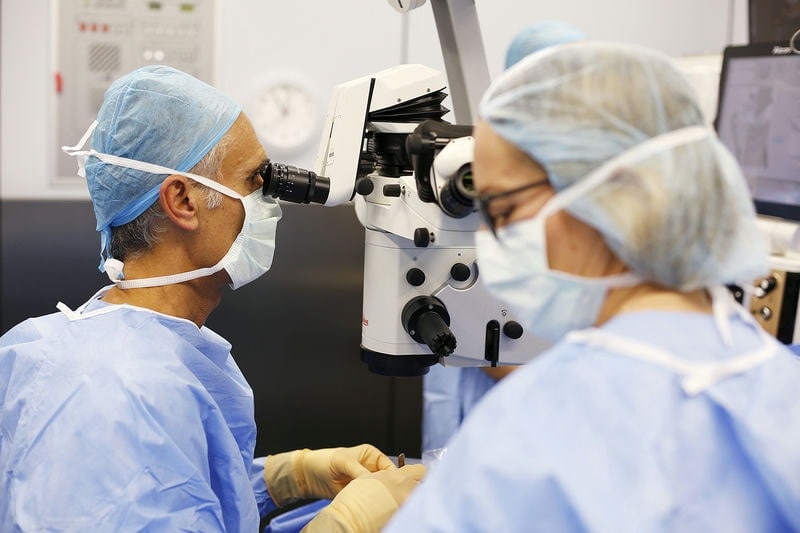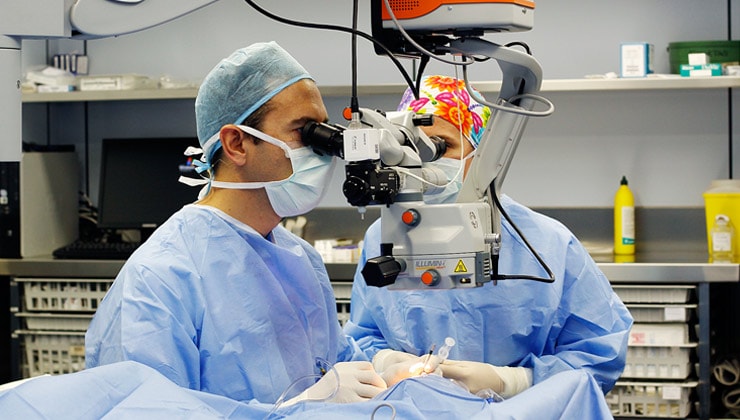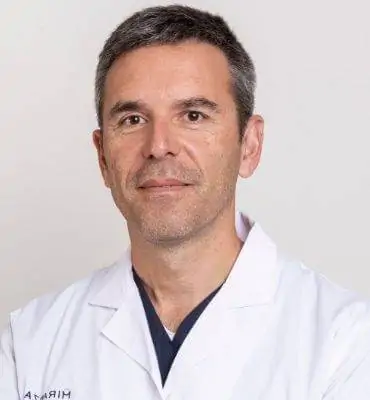
What does it involve?
The most common technique for operating cataracts is called phacoemulsification, which is performed through an incision measuring less than three millimetres, through which the opaque contents of the eye’s crystalline (natural) lens is removed.
The cataract is conventionally broken up by ultrasound, although since 2012 IMO has also included the option of using the femtosecond laser, which is also used to make the incision. The laser is especially useful in complex cases, as it offers a high degree of precision.
Once the cataract has been broken up, a tube then aspirates it and the intraocular lens is fitted in the sack enveloping the crystalline lens to avoid the need for correction with thick glasses.
When is it carried out?
In the past, cataracts were not operated on until the patient was almost blind, although thanks to the precision and safety of current surgical procedures using technological innovation (image-guided systems, state-of-the-art lasers, new lens designs, etc.), surgery is now carried out at increasingly earlier stages.
In general, cataract surgery is considered for three main reasons: in the case of a rise in intraocular pressure, if it is causing uveitis or when the reduction in eyesight interferes with the daily activities of the patient.
Furthermore, this procedure is sometimes recommended for basically refractive purposes. In patients with presbyopia, myopia or high hyperopia, crystalline lens surgery with intraocular lens implants not only helps to improve vision, but also allows patients to dispense with the need for glasses or contact lenses in many of their daily activities.
Prior examination
The ophthalmologist uses examination equipment to determine the type of cataract, size, location, impact on the optical quality of the eye, surgical indication and prognosis.
The tests performed on patients consist of visual acuity and eye pressure tests, biomicroscopy, OQAS (HD Analyzer), corneal topography, endothelial cell count, Optical Coherence Tomography (OCT), examination of the fundus and biometrics.
During surgery

Cataract surgery takes about ten minutes. In general, it is performed under topical anaesthesia, i.e. anaesthetic drops, meaning that there is no need to cover the eye after surgery, and the patient can see with the eye when leaving the theatre.
It requires the cooperation of the patient to keep looking at the microscope light. Where this is not possible, or in some special cataract cases, the area around the eye is anaesthetised with a local anaesthetic. In this case, the patient’s eye is covered for several hours after surgery.
After surgery
The patient can lead a normal life after surgery, but initially vision will not be perfect. Physical exercise involving sudden or violent movements should be avoided at first. It is very important for patients not to rub their eyes. At night, it is advisable not to sleep in a face-down position. It is also important to wear sunglasses when out of the house to help protect the eye and prevent glare, which is common after surgery.
Risks
All types of surgery carry some risk. Nowadays, the results of cataract surgery are excellent, and visual recovery is usually rapid and satisfactory after surgery. It is not, however, a trivial procedure and, despite 95% of all cases showing no signs of complications, this surgery causes the highest percentage of secondary problems. It therefore requires good indication and correct completion.
Associated pathologies
Testimonials

La mateixa tarda de la intervenció ja hi veia bé i encara avui, 17 anys després, segueixo sense utilitzar ulleres
Amèlia Petit
Barcelona
Experts performing this treatment
IMO Institute of Ocular Microsurgery
Josep María Lladó, 3
08035 Barcelona
Phone: (+34) 934 000 700
E-mail: international@imo.es
See map on Google Maps
By car
GPS navigator coordinates:
41º 24’ 38” N – 02º 07’ 29” E
Exit 7 of the Ronda de Dalt (mountain side). The clinic has a car park with more than 200 parking spaces.
By bus
Autobus H2: Rotonda de Bellesguard, parada 1540
Autobus 196: Josep Maria Lladó-Bellesguard, parada 3191
Autobuses H2, 123, 196: Ronda de Dalt – Bellesguard, parada 0071
How to arrive at IMO from:
IMO Madrid
C/ Valle de Pinares Llanos, 3
28035 Madrid
Phone: (+34) 910 783 783
See map in Google Maps
Public transport
Metro Lacoma (líne 7)
Autobuses:
- Lines 49 & 64, stop “Senda del Infante”
- Line N21, stop “Metro Lacoma”
Timetables
Patient care:
Monday to Friday, 8 a.m. to 9 p.m.
IMO Andorra
Av. de les Nacions Unides, 17
AD700 Escaldes-Engordany, Andorra
Phone: (+376) 688 55 44
See map in Google Maps
IMO Manresa
C/ Carrasco i Formiguera, 33 (Baixos)
08242 – Manresa
Tel: (+34) 938 749 160
See map in Google Maps
Public transport
FGC. Line R5 & R50 direction Manresa. Station/Stop: Baixador de Manresa
Timetables
Monday to Friday, 09:00 A.M – 07:00 PM







